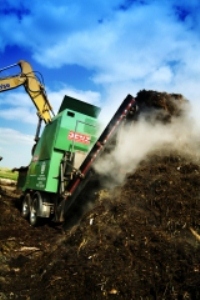
The process uses oxygen from the air and produces carbon dioxide and water.
Most Derbyshire residents have a garden waste collection service from their council. Five of the 8 Derbyshire councils collect food waste in with garden waste and one collects food waste separately. If you aren't sure whether you can include food waste with your garden waste please check with your local borough or district council. The material collected through these schemes is sent for composting.
By composting this material we stop it going to landfill. This reduces the creation of methane (a harmful greenhouse gas) which is made when organic waste (like garden and food waste, cardboard and paper) breaks down without air.
Changes to composting of cardboard
Cardboard isn't allowed to be collected with garden waste collections due to changes in national compost quality standards. Cardboard can't be included as it can contaminate the compost, reducing its quality. The contaminants include plastic from over-packaged cardboard, steel from the staples included within the cardboard packaging, plus dyes and inks that are used in cardboard packaging.
Types of composting
There are different types of composting:
- home composting
- open windrow composting
- in-vessel composting
- anaerobic digestion
Open windrow composting
Garden waste such as grass cuttings, pruning and leaves, can be composted in the open air or within large covered areas. The garden waste is piled up in long rows called ‘windrows’. The material naturally composts and is regularly turned. The material breaks down using the oxygen from the air.
In-vessel composting
Food waste collected along with garden waste has to be composted differently to meet legal requirements. The processing of all animal by-products, including kitchen waste, must comply with the animal by-products regulations.
These regulations were introduced in 2003 to ensure that all meat and other products of animal origin are dealt with to ensure the environment and human health is protected.
The waste is composted in an enclosed system which could be a container, silo, bay, tunnel, drum or an enclosed hall. Enclosing the composting enables the process to be controlled which ensures that everything, in particular the food waste, composts to meet the required composting standards.
For both open windrow and in-vessel composting the material is first shredded and then composted. The material is then screened at the end of the process to produce a range of composts and soil improvers suitable for different uses.
Anaerobic digestion (AD)
AD can only be used to treat biodegradable material, such as garden and food waste. The material is put into a closed container without oxygen. Bacteria break down the waste creating a 'biogas' that can be used as fuel or burned to create heat or electricity. A fibre is produced which can be used as a nutrient-rich soil conditioner. A liquid is also produced which can be used as a fertiliser.